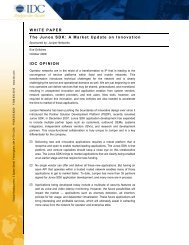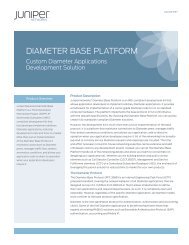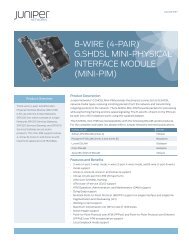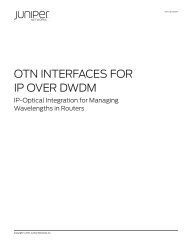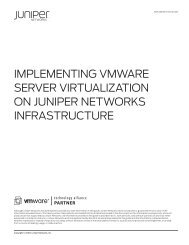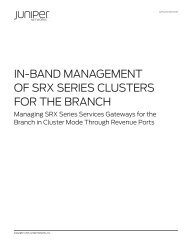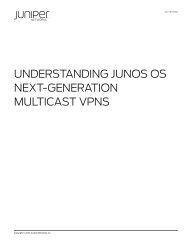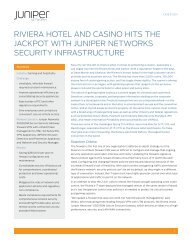Download - ICT Networks
Download - ICT Networks
Download - ICT Networks
You also want an ePaper? Increase the reach of your titles
YUMPU automatically turns print PDFs into web optimized ePapers that Google loves.
Converged<br />
Supercore<br />
T4000<br />
T4000<br />
MX Series<br />
PTX5000<br />
PTX9000<br />
MX Series<br />
IP services<br />
IP services<br />
T4000<br />
T4000<br />
Junos Trio<br />
• Subscriber scale<br />
• Services scale<br />
• Bandwidth scale<br />
Junos Express<br />
• Speed<br />
• Scale<br />
• Cost<br />
Junos Trio<br />
• Subscriber scale<br />
• Services scale<br />
• Bandwidth scale<br />
Figure 1: Requirements for service provider supercore<br />
The PTX Series Packet Transport Switch is based on Juniper<br />
<strong>Networks</strong> Junos ® Express chipset, part of the Junos One family<br />
of processors. Express uses state-of-the-art 40 nm fabrication<br />
technology and is built with “no packet drop” assurance. The PTX<br />
Series product is designed to scale up to 2 Tbps per slot and provides<br />
significant cost reduction over traditional core transport solutions.<br />
The PTX Series provides a unique combination of hardware and<br />
software features, allowing service providers to manage their<br />
supercore networks more efficiently. The platforms are built from<br />
the ground up for speed, scale, and cost optimization. The PTX<br />
Series adapts to rapidly changing traffic patterns for video, mobility,<br />
and cloud-based services. It is the first supercore packet switch<br />
in the industry that supports a single chassis with 8 and 16 Tbps<br />
capacity. The modular power design allows power efficiency on the<br />
order of 1 watt per Gbps. This is less than half the requirements of<br />
competitive platforms.<br />
A PTX Series switch working in conjunction with Juniper<br />
<strong>Networks</strong> T Series Core Routers allows a service provider to<br />
build a core network that is flexible enough to accommodate<br />
dynamically changing traffic patterns for applications, data center<br />
consolidation, mobility for devices, users, and applications, even<br />
an increase in bandwidth intensive applications such as HD video.<br />
The integration of optical transport further improves the economics<br />
of the core network. The seamless integration of IP/MPLS and<br />
optical control plane facilitates modeling, planning, simulation,<br />
provisioning, seamless management, and restoration of multiservice<br />
core networks deploying PTX Series platforms.<br />
PTX5000<br />
Juniper <strong>Networks</strong> PTX5000 is a 28 RU 8 slot system. It supports up<br />
to 8 FPCs, with each FPC supporting 2 PICs. The PTX5000 can be<br />
used as a switch for the supercore delivering statistical multiplexing<br />
and dynamic label-switched path (LSP) creation and management.<br />
PTX5000 can also function as a packet optical node delivering<br />
functionality for multiple layers in a single Juniper <strong>Networks</strong> Junos<br />
operating system-based platform. The PTX5000 can be used to<br />
build a Converged Supercore with a higher capacity compared to a<br />
core router, and it includes optical transport capabilities.<br />
PTX9000<br />
Juniper <strong>Networks</strong> PTX9000 is a 36 RU 16 slot system. It supports<br />
up to 16 FPC with each FPC supporting 2 PICs. The PTX9000<br />
can be used as a switch for the supercore delivering statistical<br />
multiplexing and dynamic LSP creation and management.<br />
PTX9000 can also function as a packet optical node delivering<br />
functionality for multiple layers in a single Junos OS-based<br />
platform. The PTX9000 can be used to build a Converged<br />
Supercore with a higher capacity compared to a core router, and it<br />
includes optical transport capabilities.<br />
Architecture and Key Components<br />
The phenomenal growth in service provider network traffic makes<br />
fundamental changes in the architecture essential. The architecture<br />
must deliver needed functionality with fewer nodes, adapt to rapid<br />
changes in both traffic pattern and volume, support automation,<br />
and most importantly be simple to ensure operational efficiency<br />
and manageability.<br />
Juniper’s vision for the new network architecture is depicted in<br />
Figure 1. It is comprised of edge, core, and supercore networks.<br />
The edge network is focused on delivering intelligent services and<br />
subscriber management capabilities to business and residential<br />
customers. The core network needs to be capable of routing<br />
functions for high traffic volumes. The supercore is laser focused<br />
on speed, cost optimization, statistical multiplexing, and dynamic<br />
LSP creation and management.<br />
2



